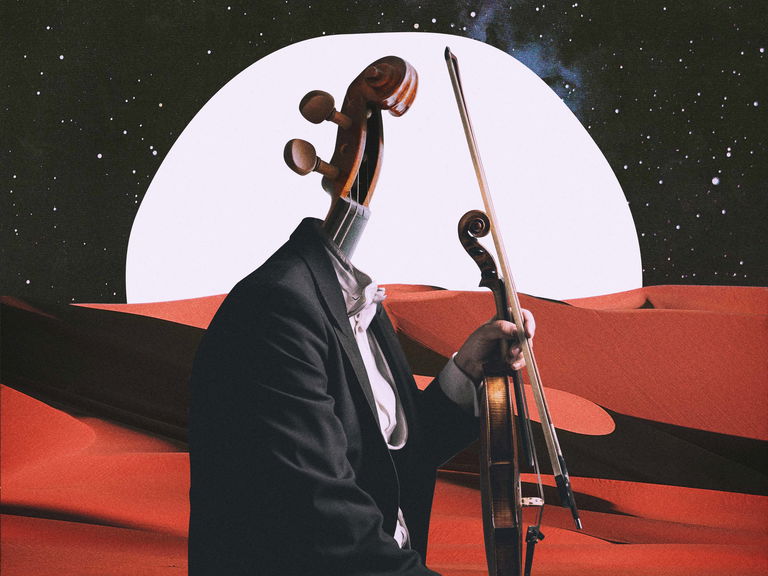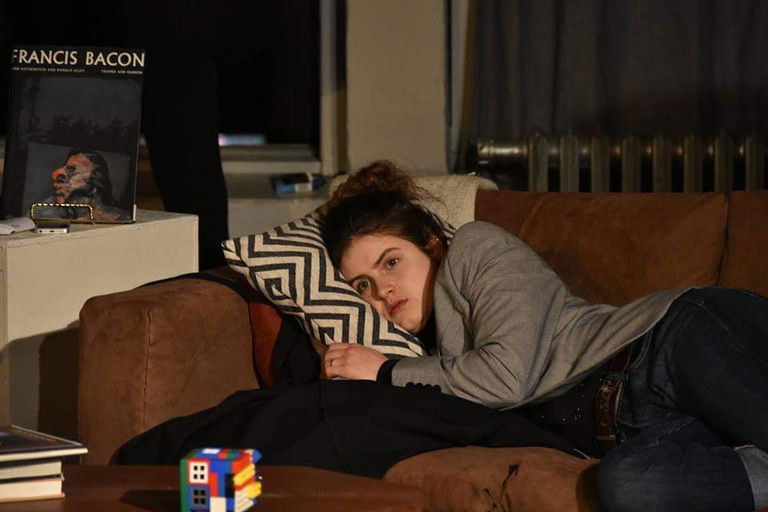
RE:ORCHESTRATING Our Future: Advancing Sustainable Development Through the Arts
Ryan Elliot Drew for Culture Days
Aug 9, 2021
A shared excitement filled the air as we apologetically sidestepped towards our seats in the renowned Teatro Monumental—a buzzing performance space in the heart of Madrid’s downtown core. Completing graduate studies in the capital city of Spain, it was on the evening of February 28th, 2020, that musicians of the RTVE Symphony Orchestra took the stage for an impassioned delivery of Sergei Prokofiev’s Symphony No. 5 in B-flat major, a substantial work written in 1944 and inspired by wartime hardship. Having previously performed this selection alongside the Prince Edward Island Symphony Orchestra, iconic themes and motifs flooded back into my memory. Witnessing the ensemble expertly sync with one another, I recall my enchantment with the orchestra’s masterful exploration of sublime drama and euphoric spirit. What I did not realize at the time, was that this would be my last viewing of live musical performance for many months to come.
In what seemed to happen overnight, the COVID-19 virus took hold of Western Europe—and the months that followed brought unconscionable tragedy and an aura of unpredictability that penetrated even the most constant facets of modern society. As leading science agencies grappled to make sense of the virus and its rampant spread across the globe, industries spiraled into shutdown. A world entering pandemic, the performative arts sector was among the first to suffer. Like so many others, musicians of the RTVE Symphony Orchestra could no longer engage with their craft, let alone their audiences, in conventional contexts. Cinema screens powered down, arts festivals were postponed, and comedy clubs were shuttered. At the same time that emerging new-normals rendered most cultural activities non-essential, people around the world sought comfort and solace through the arts. In the midst of chaos, the famed Italian tenor Andrea Bocelli was granted special exemption from the city of Milan’s quarantine to sing of hope and unity to a virtual audience of 3.4 million concurrent listeners. The largest classical music live stream in YouTube’s history, I vividly recall my own viewing of the virtual event as I weathered self-isolation measures in a tiny Montréal apartment. Providing relief from the uncanny silence and palpable tension that had beset neighborhood streets, Bocelli’s voice projected a resonating message of solidarity and faith in humanity.
In times of uncertainty, art can be a steadying force. When we marvel at something, whether it is a painting, a turn of phrase or a piece of music, we’re reminded of the human capacity to create and endure. (Chaves, 2020, para. 5).
Now, more than fifteen months since the World Health Organization officially labeled the outbreak a pandemic, the arts sector has landed on its feet. As creative industries continue to reinvent and reshape the ways people interact with art in virtual contexts, artists around the world are boldly pushing the envelope in terms of impact. As we inch closer to post-pandemic normalcy, creative industries are playing an increasingly significant role in the advancement of sustainable practices and perspectives. To an unprecedented extent, government agencies, NGOs, and other powerful actors are demonstrating strong commitment to artists and the merits of their respective creative practices. And for what cause? Artists wield not only tremendous capacity to inspire sustainable development—but also to imagine, innovate, and create bright and healthy futures.
Admittedly, the term sustainable development is both clunky and non-specific in meaning. A concept that transcends disciplinary boundaries, sustainability is perhaps best summarized as unified and disciplined commitment to both present and future populations. In short: how can we adequately satisfy the needs of people today without sacrificing the needs of future generations? Representing a fifteen-year blueprint for collaborative action, the United Nations Sustainable Development Goals (SDGs) refer to a series of science-based objectives with a deadline of 2030. The seventeen ambitious goals—which range from climate action to the reduction of inequalities—demonstrate an international commitment to three sustainability pillars: environmental, economic, and social.

Exploring contested terrain between art(ists) and sustainability, Canadian arts-researcher Dr. David Maggs describes three ways that artists uniquely advance sustainability trajectories. The first, which he refers to as greening the sector, involves “carbon accounting associated with artistic activity” and the deliberate eco-conscious retooling of personal and industry mechanisms connected to the environment (Maggs, 2020). From the recycling of theatrical props and costumes to the cutback of air travel involved in artist tour planning, effective greening of the creative sector requires intuitive and innovative thinking across a multitude of artistic disciplines. Beyond environmental considerations, this model of artist-led recognition and mitigation of adverse impact can be aptly applied within economic and social contexts as well. Regardless of artistic medium, the fruit of impassioned creativity often conveys abstract messaging that can have tangible and measurable impact on society.
For the creative sector to truly harness the unifying and transformative power of creative practitioners, it is essential that theatre halls, concert venues, galleries, record labels, festival planning committees, and other leading arts entities develop informed sensitivity to the cultural impacts of presented work. For example: might certain creation or dissemination processes directly or indirectly perpetuate racial, gender-based, or socio-economic divides? Furthermore, how might the thematic content or perceived aesthetic character of a given work impact marginalized communities? Just as creative industries can advocate for progressive environmental policies, conscious effort can also be made to address social and economic injustices.
The second way that artists advance sustainability is through the aestheticizing of known scientific information. Built upon the notion that media consumers lack adequate environmental knowledge and/or key perspectives, the artist might raise the profile of select issues through the crafting of artistic communications. For example: National Geographic has brought considerable awareness to melting glaciers through photography of disrupted northern wildlife. Likewise, demonstrating projected coastline erosion within Atlantic Canada, artist Rilla Marshall debuted an installation in 2014 that illuminated Charlottetown, Prince Edward Island’s imminent loss of land to the ocean. Featuring a series of intricately placed pegs along the shore, onlookers were exposed to future realities incompatible with their points of observation—land soon to disappear beneath the waves (Murchie, para. 9).
Thirdly, Maggs articulates his vision of artists as conceptual engineers. Beyond simply advocating for awareness of sustainability principles, artists can act as innovators and leaders of positive change. Speaking to environmental concerns, what Maggs refers to as reauthoring the world involves:
turning to art to explore meanings, identities, and purposes beyond carbon economies. Here, the goal is not to inspire and support climate art that carries “the message” to diverse communities, but to embolden communities to find their own climate visions through the aesthetic. (Maggs, 2020).
Intimately connected to respective creative processes, there remains a great deal to be learned from the ways that artists engage with and resolve internally-defined problems. No doubt, environmental, economic, and social pillars of sustainability require creative solutions to complex and ever-evolving issues.

A jarring disruption to creative industries across the globe, COVID-19 has presented a tremendous opportunity for artists to reorchestrate the future. Members of the RTVE Symphony Orchestra have since returned to the Teatro Monumental. Museums, libraries, and art galleries are welcoming communities back into shared spaces. And, while many share an insatiable yearning for pre-pandemic comfort and to reclaim what feels like a year of lost time and experience, modern science shows that a bright and healthy 2030 is only possible through collective, urgent, and informed action. Pioneers of the imagination, the artist’s intimate familiarity with creative processes appropriately reflects their capacity to engineer pathways forward. There are very good reasons why the United Nations has designated 2021 the International Year of Creative Economy for Sustainable Development. In designing the post-pandemic world, creative people are among our greatest assets.
Chaves, A. (2020, March 17). In times of crisis, we still need to turn to the arts. The National News. https://www.thenationalnews.com/arts-culture/comment/in-times-of-crisis-we-still-need-to-turn-to-the-arts-1.993920
Maggs, D. (2020, July 20). Art, after virus: Seven questions for a sector on the edge. The Philanthropist Journal. https://thephilanthropist.ca/2020/07/art-after-virus-seven-questions-for-a-sector-on-the-edge/
Murchie, J. (2014, October 27). A Walk Through Charlottetown’s Art in the Open 2014. Visual Arts News. https://visualartsnews.ca/2014/10/a-walk-through-charlottetowns-art-in-the-open-2014/
I dedicate this short article to those who would accompany me to the Teatro Monumental: Anna, Jessica, Ryan, and Taya. We learned many valuable lessons during our symphony excursion.
I would like to acknowledge that this short article was researched and written on the traditional and unceded territory of the Mi’kmaq people.
This article is part of a special blog series featuring writers and creatives from across Canada (and beyond!) with stories that both highlight and celebrate Culture Days’ 2021 theme, RE:IMAGINE. Explore more stories below.
- The Road Less Travelled: Three artists reimagine success and career by Linh S. Nguyễn
- Arts in Motion by Aaron Rothermund
- Reimagining Public Spaces: The Share-It-Square in Portland, Oregon by Laura Puttkamer
- Refresh: How a Year on Instagram Redefined Artistic Communities by Eva Morrison
- RE:PURPOSE by Mike Green
- Recalibrating: A Look at Opera InReach by Anya Wassenberg
- Reimagine—How the Disability Community Accesses the Arts by Rachel Marks
- Reimagining Community and the Workplace of Theatre by Natércia Napoleão
- Helm Studios flips the for-profit music model to empower artists by Aly Laube
- Curating INUA, Canada’s newest Inuit art exhibit by Carolyn B. Heller
- When Less is More: What Theatre Can Learn From a Year in Slow Motion by Megan Hunt
- RE:DEFINING Normal: A Prescription for a Canadian Cultural Landscape in Recovery by Valerie Sing Turner
- Empathy Machines?: Exploring the Relationship between Immersive Art Technologies and Feeling by Jozef Spiteri and Sunita Nigam
- La poésie pour vivre différemment la pandémie par Jérôme Melançon




